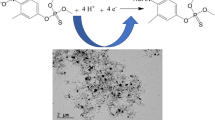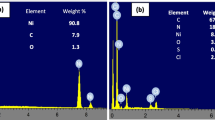Abstract
This work outlines a simple fabricated microneedle electrode for sensitive and real sample monitoring of plant polyphenolics. The electrode was fabricated by layer-by-layer assembly (LBL) with nanocomposite of carbon nanotubes (CNT) and cellulose nanocrystals (CNC) as the first layer, followed by polyaniline (PANI), and finally, the 3-(glycidyloxypropyl)trimethoxysilane (GOPS) layer as the binding agent. The microneedle electrodes were characterized by scanning electron microscopy (SEM), electrochemical impedance spectroscopy (EIS), Fourier transform infrared (FTIR) spectroscopy, and Raman spectroscopy. The developed microneedle electrodes were successfully applied for the capacitive detection of gallic acid (GA) and chlorogenic acid (CA) as polyphenol model compounds. The microneedle electrode was also used to quantify polyphenols in orange juice. The electrochemical capacitance responses were linearly proportional to the concentrations of GA and CA in the range of 0.1–87.23 μg/mL for GA and 0.1–78.01 μg/mL for CA. The calculated detection limits (LOD) for GA and CA were found to be 0.29 ± 0.2 μg/mL and 0.34 ± 0.2 μg/mL respectively. As minimally invasive technology, microneedle electrodes were found to be promising for successful in situ screening of antioxidants in different fruit matrices. The microneedle electrodes were also applied to the depth profiling of antioxidant content in fruit samples.

Graphical abstract








Similar content being viewed by others
Abbreviations
- APS:
-
Ammonium peroxydisulfate
- Amp:
-
Amperometry
- AuMCs:
-
Gold microclusters
- CA:
-
Chlorogenic acid
- CNT:
-
Carbon nanotubes
- CNC:
-
Cellulose nanocrystals
- CCE:
-
Carbon ceramic electrode
- CS:
-
Chitosan
- ChCl:
-
Chlorine chloride
- CPE:
-
Carbon paste electrode
- COF:
-
Covalent organic framework
- CV:
-
Cyclic voltammetry
- DPV:
-
Differential pulse voltammetry
- Delph:
-
Delphinidin
- DMC:
-
Defective mesoporous carbon
- DMTP:
-
2,5-Dimethoxyterephaldehyde
- EIS:
-
Electrochemical impedance spectroscopy
- ERGO:
-
Electrochemically reduced graphene oxide
- FIA:
-
Flow injection amperometry
- fFe2O3 :
-
Fishbone-shaped Fe2O3
- FTO:
-
Flourine doped tin oxide
- GOPS:
-
3-(Glycidyloxypropyl)trimethoxysilane
- GA:
-
Gallic acid
- GCE:
-
Glassy carbon electrode
- IL:
-
Ionic liquid
- LBL:
-
layer by layer
- LOD:
-
Limit of detection
- MIP:
-
Molecularly imprinted polymer
- MIL-100(Fe):
-
Metal organic framework
- MIS:
-
Molecularly imprinted siloxane
- MPC:
-
Macroporous carbon
- MWCNT:
-
Multiwalled carbon nanotubes
- NPs:
-
Nanoparticles
- PANI:
-
Polyaniline
- PME:
-
Polymelamine electrode
- PmPD:
-
Poly(m-phenylenediamine)
- PAL:
-
Palygorskite
- PEP:
-
Polyepinephrine
- PEG:
-
Pencil graphite electrode
- PDDA:
-
Poly(diallyldimethylammonium chloride)
- POM:
-
Polyoxometalates
- rGO:
-
Reduced graphene oxide
- SF:
-
Sulfonate
- SPCE:
-
Screen-printed carbon electrode
- SEM:
-
Scanning electron microscopy
- SWV:
-
Square wave voltammetry
- TABP:
-
1,3,5-Tris(4-aminophenyl)benzene
- TNrGO:
-
Titanium nitride doped graphene oxide
- TPM:
-
3-(Trimethoxysilyl)propyl methacrylate
- VTMS:
-
Vinyltrimethoxysilane
- WCrGO:
-
Wolfram carbide doped graphene oxide
References
Cho AS, Jeon SM, Kim MJ, Yeo J, Seo K, Choi MS, et al. Chlorogenic acid exhibits anti-obesity property and improves lipid metabolism in high-fat diet induced-obese mice. Food Chem Toxicol. 2010;48:937–43.
Su YL, Cheng SH. Sensitive and selective determination of gallic acid in green tea samples based on an electrochemical platform of poly(melamine) film. Anal Chim Acta. 2015;901:41–50.
Mudnic I, Modun D, Rastija V, Vukovic J, Brizic I, Katalinic V, et al. Antioxidative and vasodilatory effects of phenolic acids in wine. Food Chem. 2010;119:1205–10.
Francisco V, Costa G, Figueirinha A, Marques C, Pereira P, Neves BM, et al. Anti-inflammatory activity of Cymbopogon citratus leaves infusion via proteasome and nuclear factor-κB pathway inhibition: contribution of chlorogenic acid. J Ethnopharmacol. 2013;148:126–34.
Naso LG, Valcarcel M, Roura-Ferrer M, Kortazar D, Salado C, Lezama L, et al. Promising antioxidant and anticancer (human breast cancer) oxidovanadium (IV) complex of chlorogenic acid synthesis, characterization and spectroscopic examination on the transport mechanism with bovine serum albumin. J Inorg Biochem. 2014;135:86–99.
Limpisophon K, Schleining G. Use of gallic acid to enhance the antioxidant and mechanical properties of active fish gelatin film. J Food Sci. 2017;82:80–9.
Blainski A, Lopes GC, De-Mello JCP. Application and analysis of the Folin Ciocalteu method for the determination of the total phenolic content from Limonium Brasiliense L. Molecules. 2013;18:6852–65.
Zhao Y, Wang J, Ballevre O, Luo H, Zhang W. Antihypertensive effects and mechanisms of chlorogenic acids. Hypertens Res. 2012;35:370–5.
Chao M, Ma X. Voltammetric determination of chlorogenic acid in pharmaceutical products using poly (aminosulfonic acid) modified glassy carbon electrode. J Food Drug Anal. 2014;22:512–9.
Qing-Hua Y, Li Y, Qing W, Xiao-Qin M. Determination of chlorogenic acid, ferulic acid and flavonoids in FlosLoniceae by high performance liquid chromatography. Asian J Chem. 2011;23:4709–10.
Denderz N, Lehotay J. Using molecularly imprinted polymers for determination of gallic and protocatechuic acids in red wines by high performance liquid chromatography. J Chromatogr A. 2014;1372:72–80.
Füzfai Z, Molnár-Perl I. Gas chromatographic–mass spectrometric fragmentation study of flavonoids as their trimethylsilyl derivatives: analysis of flavonoids, sugars, carboxylic and amino acids in model systems and in citrus fruits. J Chromatogr A. 2007;1149:88–101.
Santos SAO, Vilela C, Freire CSR, Neto CP, Silvestre AJD. Ultra-high performance liquid chromatography coupled to mass spectrometry applied to the identification of valuable phenolic compounds from Eucalyptus wood. J Chromatogr B. 2013;938:65–74.
Zhang J, Chen M, Ju W, Liu S, Xu M, Chu J, et al. Liquid chromatograph/tandem mass spectrometry assay for the simultaneous determination of chlorogenic acid and cinnamic acid in plasma and its application to a pharmacokinetic study. J Pharm Biomed. 2010;51:685–90.
Corominas BGT, Mateo JVG, Zamora LL, Calatayud JM. Determination of tannic acid by direct chemiluminescence in a FIA assembly. Talanta. 2002;58:1243–51.
Wang X, Wang J, Yang N. Chemiluminescent determination of chlorogenic acid in fruits. Food Chem. 2007;102:422–6.
Magalhães LM, Santos M, Segundo MA, Reis S, Lima JLFC. Flow injection based methods for fast screening of antioxidant capacity. Talanta. 2009;77:1559–66.
Hečimović I, Belščak-Cvitanović A, Horžić D, Komes D. Comparative study of polyphenols and caffeine in different coffee varieties affected by the degree of roasting. Food Chem. 2011;129:991–1000.
Mannino S, Wang J. Electrochemical methods for food and drink analysis. Electroanalysis. 1992;9:835–40.
Mugo SM, Edmunds BJ, Berg D, Gill N. An integrated carbon entrapped molecularly imprinted polymer (MIP) electrode for selective voltammetric detection of resveratrol in wine. Anal Methods. 2015;7:9092–9.
Albelaez JH, Vazquez M, Calderon JC. Electrochemical methods as a tool for determining the antioxidant capacity of food and beverages: a review. Food Chem. 2017;221:1371–81.
Cochet M, Louarn G, Quillard S, Buisson J, Lefrant S. Theoretical and experimental vibrational study of emeraldine in salt form. J Raman Spectrosc. 2000;31:1041–9.
Dresselhaus MS, Dresselhaus G, Saito R, Jorio A. Raman spectroscopy of carbon nanotubes. Phys Rep. 2005;409:47–99.
Kar P, Choudhury A. Carboxylic acid functionalized multi-walled carbon nanotube doped polyaniline for chloroform sensors. Sensors Actuators B Chem. 2013;183:25–33.
Salvatierra RV, Oliveira MM, Zarbin AJ. One-pot synthesis and processing of transparent, conducting, and freestanding carbon nanotubes/polyaniline composite films. Chem Mater. 2010;22:5222–34.
Bachhav SG, Patil DR. Synthesis and characterization of polyaniline-multiwalled carbon nanotube nanocomposites and its electrical percolation behavior. Am J Mater Sci. 2013;5:90–5.
Kulkarni MV, Kale BB. Studies of conducting polyaniline (PANI) wrapped-multiwalled carbon nanotubes (MWCNTs) nanocomposite and its application for optical pH sensing. Sensors Actuators B Chem. 2013;187:407–12.
Oueiny C, Berlioz S, Perrin FX. Carbon nanotube-polyaniline composites. Prog Polym Sci. 2014;39:707–48.
Ginic-Markovic M, Matisons JG, Cervini R, Simon GP, Fredericks PM. Synthesis of new polyaniline/nanotube composites using ultrasonically initiated emulsion polymerization. Chem Mater. 2006;18:6258–65.
Xiong C, Wang Y, Qu H, Zhang L, Qiu L, Chen W, et al. Highly sensitive detection of gallic acid based on organic electrochemical transistors with poly(diallyldimethylammoniumchloride) and carbon nanomaterials nanocomposites functionalized gate electrodes. Sensors Actuators B Chem. 2017;246:235–42.
Puangjan A, Chaiyasith S. An efficient ZrO2/Co3O4/reduced graphene oxide nanocomposite electrochemical sensor for simultaneous determination of gallic acid, caffeic acid and protocatechuic acid natural antioxidants. Electro Chim Acta. 2016;211:273–88.
Ghaani M, Nasirizadeh N, Ardakani SAY, Mehrjardi FZ, Scampicchio M, Farris S. Development of an electrochemical nanosensor for the determination of gallic acid in food. Anal Methods. 2016;8:1103–10.
Shojaei S, Nasirizadeh N, Entezam M, Koosha M, Azimzadeh M. An electrochemical nanosensor based on molecularly imprinted polymer (MIP) for detection of gallic acid in fruit juices. Food Anal Methods. 2016;9:2721–31.
Gopal P, Reddy TM, Palakollu VM. Development, characterization and application of a carbon based nanomaterial composite as an electrochemical sensor for monitoring natural antioxidant (gallic acid) in beverages. ChemistrySelect. 2017;2:3804–11.
Shahamirifard SA, Ghaedi M, Razmi Z, Hajati S. A simple ultrasensitive electrochemical sensor for simultaneous determination of gallic acid and uric acid in human urine and fruit juices based on zirconia-choline chloride-gold nanoparticles modified carbon paste electrode. Biosens Bioelectron. 2018;114:30–6.
Tashkhourian J, Nami-Ana SF. A sensitive electrochemical sensor for determination of gallic acid based on SiO2 nanoparticle modified carbon paste electrode. Mater Sci Eng C. 2015;52:103–10.
Hamid RA, Newair EF. Adsorptive stripping voltammetric determination of gallic acid using an electrochemical sensor based on polyepinephrine/glassy carbon electrode and its determination in black tea sample. J Electroanal Chem. 2013;704:32–7.
Tashkhourian J, Nami-Ana SF, Hashemnia S, Hormozi-Nezhad MR. Construction of a modified carbon paste electrode based on TiO2 nanoparticles for the determination of gallic acid. J Solid State Electrochem. 2013;17:157–65.
Gao F, Zheng D, Tanaka H, Zhan F, Yuan X, Gao F, et al. An electrochemical sensor for gallic acid based on Fe2O3/electroreduced graphene oxide composite: estimation for the antioxidant capacity index of wines. Mater Sci Eng C. 2015;57:279–87.
Stanković DM, Ognjanović M, Martin F, Švorc L, Mariano JFML, Antić B. Design of titanium nitride- and wolfram carbide-doped RGO/GC electrodes for determination of gallic acid. Anal Biochem. 2017;539:104–12.
Wang X, Tan W, Wang Y, Wu D, Kong Y. Electrosynthesis of poly(m-phenylenediamine) on the nanocomposites of palygorskite and ionic liquid for electrocatalytic sensing of gallic acid. Sensors Actuators B Chem. 2019;284:63–72.
Liang Z, Zhai H, Chen Z, Wang H, Wang S, Zhou Q, et al. A simple, ultrasensitive sensor for gallic acid and uric acid based on gold microclusters/sulfonate functionalized graphene modified glassy carbon electrode. Sensors Actuators B Chem. 2016;224:915–25.
Wegiel J, Burnat B, Skrzypek S. A graphene oxide modified carbon ceramic electrode for voltammetric determination of gallic acid. Diam Relat Mater. 2018;88:137–43.
Gao Y, Wang L, Zhang Y, Zou L, Li G, Ye B. Highly sensitive determination of gallic acid based on a Pt nanoparticle decorated polyelectrolyte functionalized graphene modified electrode. Anal Methods. 2016;8:8474–82.
Santos WDJR, Santhiago M, Yoshida IPV, Kubota LT. Novel electrochemical sensor for the selective recognition of chlorogenic acid. Anal Chim Acta. 2011;695:44–50.
Ribeiro CM, Miguel EM, Silva JDS, Silva CBD, Goulart MOF, Kubota LT, et al. Application of a nanostructured platform and imprinted sol-gel film for determination of chlorogenic acid in food samples. Talanta. 2016;157:119–25.
Chen Y, Huang W, Chen K, Zhang T, Wang Y, Wang J. A novel electrochemical sensor based on core-shell-structured metal-organic frameworks: the outstanding analytical performance towards chlorogenic acid. Talanta. 2019;196:85–91.
Zhang T, Chen Y, Huang W, Wang Y, Hu X. A novel AuNPs-doped COFs composite as electrochemical probe for chlorogenic acid detection with enhanced sensitivity and stability. Sensors Actuators B Chem. 2018;276:362–9.
Mohammadi N, Najafi M, Adeh NB. Highly defective mesoporous carbon – ionic liquid paste electrode assensitive voltammetric sensor for determination of chlorogenic acid in herbal extracts. Sensors Actuators B Chem. 2017;243:838–46.
Yang X, Wang Z, Chen P, Sun D. Surface enhancement of porous alumina microfibers toward electrochemical sensing of chlorogenic acid. Microchem J. 2019;145:801–5.
Acknowledgments
Mugo research group acknowledges funding from the Natural Sciences and Engineering Research Council of Canada (NSERC) and MacEwan University Research.
Author information
Authors and Affiliations
Corresponding author
Ethics declarations
Conflict of interest
Authors declare that they have no competing interests.
Additional information
Publisher’s note
Springer Nature remains neutral with regard to jurisdictional claims in published maps and institutional affiliations.
Rights and permissions
About this article
Cite this article
Dhanjai, Mugo, S.M. & Lu, W. Modified stainless steel microneedle electrode for polyphenolics detection. Anal Bioanal Chem 412, 7063–7072 (2020). https://doi.org/10.1007/s00216-020-02836-w
Received:
Revised:
Accepted:
Published:
Issue Date:
DOI: https://doi.org/10.1007/s00216-020-02836-w




